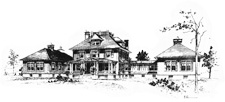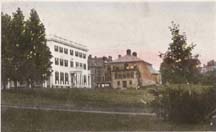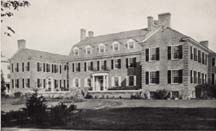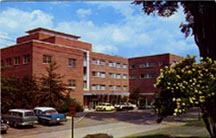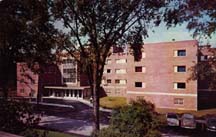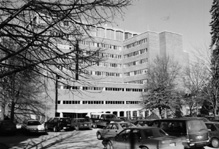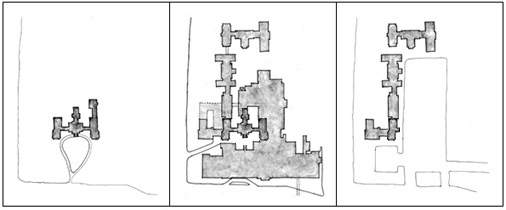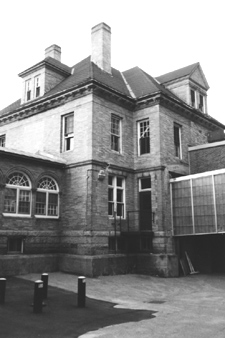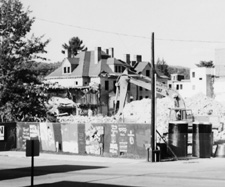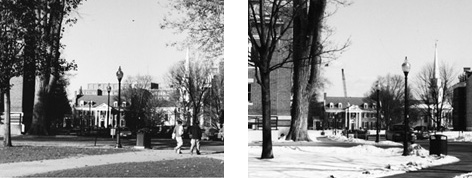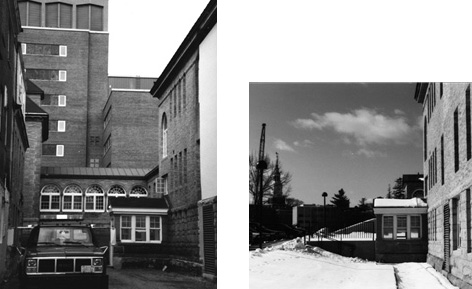
| ||||||||||||||||||
| ||||||||||||||||||
| 6 November 2001 | Update: Dartmouth plans to build two new dormitories and a dining hall on the south end of the old hospital site, facing Maynard Street. After a multi-firm competition for a master plan for the north part of campus, the school selected Moore Ruble Yudell, partnered with Bruner/Cott & Associates of Boston for the proposed $75m expansion. (The Dartmouth printed a short interview with Buzz Yudell.) For more information, see "Dartmouth's New North Campus Master Plan." Earlier outlines of the project are available in an article on the school's overall master plan and a Dartmouth press release. The Dartmouth also printed more information on Lo-Yi Chan's update of the campus master plan. | |||||||||||||||||
|
MHMH 1893 | |||||||||||||||||
|
1 John King Lord 1928. 2 Linda Preotle, "A Link throuth the Years with Mary Maynard Hitchcock," (revised 1975), MHMH vertical File, Dartmouth College Special Collections. 3 Ibid. 4 John D. Thompson and Grace Goldin, The Hospital: A Social and Architectural History (New Haven: Yale University Press, 1975), 175. 5 Sherry H. Olson, Baltimore: The Building of an American City (Baltimore: Johns Hopkins University Press, 1997), 237. 6 Olson on 441n80 cites Harvey Cushing, The Life of Sir William Osler (Oxford: Oxford University Press, 1925), 303.
 MHMH from southwest (link to image at American Memory, Library of Congress). MHMH from Bartlett Tower (link to image at American Memory, Library of Congress). |
Workers with the firm of Bishop & Cutting of Worcester, Ma.1 began laying the foundation for the hospital in 1889 in the northern part of Hanover, N.H. They finished the project in May of 1893. Prominent Hanoverian Hiram Hitchcock paid for the building in memory of his wife, Mary Maynard Hitchcock, who had died in 1887 at the age of fifty-three.2 The hospital was a state-of-the-art complex on the pavilion model, in which different groups of patients occupied distinct pods. Boston architects Rand & Taylor designed the building, placing the men's ward in the eastern wing and the women's in the western wing. The hospital continued to grow, and added a number of large additions between 1913 and the 1980s. Additional institutions also joined the complex, including the College infirmary, a physicians' clinic and a nurses' school. In 1991 the hospital sold its buildings to the College and moved to a new site outside of town, and most of the hospital was demolished. The fragments that survive now face a parking lot but retain a few clues to their original identity. Mr. Hitchcock made his money as proprietor of the Fifth Avenue Hotel in New York City, which he had established with two partners in 1852. He had grown up in Drewsville, N.H. and met his future wife Mary Maynard there before moving to New York. Once Hiram became semi-retired from the hotel business, the Hitchcocks moved to Hanover in 1866. The couple traveled while Hiram studied archeology and became a state representative and a bank president.3 He also received an honorary A.M. from Dartmouth in 1872 and became a trustee in 1878. Hitchcock envisioned an up-to-date hospital, and as such his list of models must have included the Johns Hopkins Hospital. This was a pioneering venture in American hospital planning that had played out over the previous decade in Baltimore, where Mr. Hopkins had donated a complex intended for 400 patients on a 13-acre site. Hopkins stipulated that the designers study hopitals around the world for the best design,4 and even the preliminary plans solicited from five notable doctors became influential when they were printed in 1875. John Billings, who had gained experience in tent hospitals in the Civil War, laid out the final Hopkins plan.5 Construction began in 1877 and the building opened in 1885, notable for its efficient layout and sophisticated ventilation system: the plan featured a central administration building flanked by symmetrical wards, behind which were aligned two rows of pavilions. Ironically it was Hiram Hitchcock's Fifth Avenue Hotel that served as a management example for the Johns Hopkins Hospital. Early in the preparation for the hospital Dr. William Osler, the Hopkins Hospital Director, met with Hopkins University President D.C. Gilman at the hotel to discuss management. Gilman said, "There is no difference really between a hospital and a hotel" and "The clinical unit of a hospital is the exact counterpart of one of the subdivisions of any great hotel or department store."6 | |||||||||||||||||
| ||||||||||||||||||
|
7 Professor Rev. Henry Fairbanks built the mansion in 1864, and the College demolished it in the 1920s to make room for Russell Sage Hall. The first portion of what is now Tuck Mall was originally the driveway to the house. Hiram Hitchcock died in 1900 and his second wife Emily Hitchcock Howe donated the estate to the College in 1912--this included everything south of Webster Avenue and north of the cemetery. 8 Alice Pollard, in Hanover: A Bicentennial Book, Francis Lane Childs, ed. (Hanover, 1961), 200. American Architect and Building News 49, no. 1024 (10 August 1895), 59-62. 9 Ibid. 10 Eugene Julius Grow, "The Mary Hitchcock Memorial Hospital," The Granite Monthly 21, no. 5 (November 1896), 246-58. |
The Mary Hitchcock Memorial Hospital occupied a site of seven acres of farmland at the north end of town, about 160 yards north of Dartmouth College. At the time only a few farm buildings occupied the site, along the western side on Rope Ferry Road. To join this street to College Street on the east, workers built the Maynard Street across the ravine. The building site also required fill, and the ravine it occupied is still visible to the south by the Berry Library. The site of the hospital was also close to Hitchcock's house at 20 North Main St., one of the more flamboyant Victorian mansions in town.7 The hospital stood near the Medical School as well, which at the time occupied its original 1811 structure on the hill where the Fairchild Center now stands. Medical students had their own entrance to the hospital's operating theater on the east side, nearest the School. The MHMH complex followed a plan similar to that of Johns Hopkins, on a much reduced scale. The hospital consisted of four distinct buildings: a central administration block, the two flanking pavilions connected by thirty-five foot corridors, and a two-story surgical building connected by a conservatory to the eastern pavilion. This auditorium was the surgical teaching center of the Medical School and seated 125 observers. The three-story central administration block had a two-story ell behind containing the hospital dining room with some nurses' quarters above. One entered the building through a port-cochere and verandah leading to a sixteen-foot diameter rotunda. A hipped roof with dormers surmounted the central building, while the two pavilions were domed.8 Vaulted floors of Guastavino tiles and the use of very little wood made the MHMH complex nearly fireproof. A thorough contemprary article in the architectural press described the MHMH as "the first [building], and the first hospital in America, which has been planned especially for the use of this method throughout."9 Mr. Hitchcock had instructed the architects to "spare no reasonable expense" and the three main buildings cost about $90,000 when a conventional "slow-burning" building would have cost about $75,000. Other materials included long mottled yellow-gray Pompeiian brick and light-red Spanish tile roofs. A good deal of terra-cotta provided ornamentation for pilaster capitals and other elements. The large Corinthian columns in the rotunda were of cast iron. Despite concern for scientific rationalism, the architects gave the hospital a domestic appearance that they deemed appropriate to its function. At the turn of the century, especially in rural New Hampshire, hospitals were still competing with the home as a place where people should convalesce. The building's scale and massing are carefully unintimidating and fit into the village setting, despite the stylishness of the Renaissance exterior. The hospital stood behind a broad lawn and was reached by a circular carriage drive. The rotunda that formed the entrance to the hospital had an inglenook with a fireplace, as well as the hospital monogram rendered in a floor mosaic.10 | |||||||||||||||||
| ||||||||||||||||||
11 AABN 17, no. 471 (5 January 1885): 6. 12 AABN 34, no. 834 (19 December 1891): 186. 13 AABN 58, no. 1146 (11 December 1897). |
Rand & Taylor had experience designing hospitals in the northeast, including the Bancroft Building "for Lady Patients" at the Concord State Insane Asylum11 and the vast State Asylum for the Insane in Waterbury, Vermont.12 After the Mary Hitchcock the firm would design the Heaton Hospital in Montpelier, Vermont,13 which follows the same pavilion layout as the MHMH though in an even more domestic wooden cottage idiom. | |||||||||||||||||
|
Additions | |||||||||||||||||
| 14 Lord, 52. 15 Land, 21-22, 46. 16 Barrett, 100. | The architects intended the hospital to be expansible to the north, and within two decades the institution began expanding. Mrs. Dawn L. Hitchcock of Gorham, N.H. added two-thirds to the hospital's capacity by funding the Hitchcock Wards, also called A&B Wards, in 1913.14 This building stood north of the women's ward to balance the surgical building opposite and now bears the name of 5 Rope Ferry Road. The Billings and Lee families donated a nurses' home in 1920 to house 37 students in the MHMH Nurses' School, which had been another benefaction of Hitchcock's15 This dormitory building aligned with the A&B Wards and still stands. Just south of this building the parents of Richard Hall donated the College infirmary, Dick's House, in 1927. Jens Larson designed that building as well as the Hitchcock Clinic of 1938,16 which connects to the women's ward to the west and is now called 1 Rope Ferry Road. | |||||||||||||||||
| ||||||||||||||||||
|
These were not the only additions. A three-story east-west addition between the Hitchcock Wards and the operating room opposite appeared in 1927; the Carter X-Ray Building opened in 1930, replacing the original corridor connecting the men's ward rooms to the surgery building. A new heating plant appeared in the late 1930s north of surgery, and by 1938 there was a four story lab wing next to Carter. | |||||||||||||||||
|
||||||||||||||||||
17 Rebecca Gallagher Williams, chapter in Hanover: A Bicentennial Book, Francis Lane Childs, ed. (Hanover, 1961), 203. The government, under the Hill-Burton Act, recognized the hospital's role as an area medical center and granted $900,000 (fundraising campaigns of the late 1930s had stressed that the hospital served fifty summer camps in the area); MHMH 1952-"A New Era of Service" [pamphlet for the opening of Faulkner], "The MHMH is your Summer Hospital [1936 appeal], both in MHMH Vertical File, Dartmouth College Special Collections. 18 Boston Sunday Globe (March 24, 1968). 19 Norris Cotton Cancer Center pamphlet in MHMH Vertical File, Dartmouth College Special Collections. |
The most important hospital addition came in 1952 when the hospital added the four-story Faulkner House, for which Mrs. Marianne Faulkner of Woodstock had given $1 million in memory of her husband Edward Daniels Faulkner.17 Unlike previous accretions this modernist building stood in front of the old hospital, relegating the 1893 building to the status of "addition." Around 1970 the hospital corporation doubled the height of Faulkner House by adding four floors. By now going vertical seemed the only way to expand, as six new Medical School buildings over the next ten years would close off the east for possible expansion. One building was quite close, Kellog Auditorium of 1962, standing just northeast of the hospital.18 The last major addition to the hospital came in 1973 with the dedication of the Norris Cotton Cancer Center to east, much of which was underground.19 | |||||||||||||||||
| ||||||||||||||||||
20 Frank J. Barrett, Jr.. Hanover, New Hampshire (Dover, N.H.: Arcadia Publishing, 1997), 102. The building was remodeled in 1993 by R.M. Kliment and Frances Halsband. |
A complex of buildings connected with the hospital also grew across Maynard Street to the south, as the tunnel in the central plan above indicates. These buildings included Parker House, moved there from College Street; the 1968 Mental Health ward, now the Sudikoff computer science building; the post-war Winifred Raven Convalescent Home, later College offices; and the adjoining 1896 Fowler (Gile) House, demolished in 1992.20 | |||||||||||||||||
| ||||||||||||||||||
Demolition | ||||||||||||||||||
|
In 1985, the Dartmouth Hitchcock Medical Center, which is what the MHMH and its associated parts had become, decided to move to a 250 acre site on Route 120 in Lebanon. The College bought most of the Hospital's Hanover property in 1989. College designers revealed the potential of keeping the old hospital buldings by constructing a two-story connector (c.1994) between Dick's House and the Hitchcock Ward and clearing a 1950s addition from that building to create an intimate quadrangle. New occupants and new uses are to be expected in old buildings, and for a short time some College offices such as Career Services moved into the old hospital to make room for renovation of their permanent home in the Collis Center. Other functions such as Safety and Security and Facilities Planning moved permanently into the buildings on the western edge of the complex. | ||||||||||||||||||
| ||||||||||||||||||
|
21 "A Comprehensive Report on Facilities Planning at Dartmouth College" (May 1991). |
But the hospital's size, location and style placed it in peril. The College hired Venturi, Scott Brown and Associates to devise a plan to deal with the hospital property. The firm's early schemes attempt to save large parts of the building, in one option renovating Faulkner House's western tower as a fragment along with the old building behind. The tower was to form an end to the new axis the firm had established in their proposal for a mall linking the Berry Library to Maynard Street. This scheme VSBA called "Modified Full House." Though the mall and library addition would emerge as definite goals, the College would opt to "Go for the Vision" and demolish the hospital.21 | |||||||||||||||||
| ||||||||||||||||||
22 Ibid. | The possibility of placing parking lots on the hospital site clearly enticed planners, because it would allow the new mall to displace the parking that occupied the ravine at the time. The modernist styling of the most visible component of the complex, the "architecturally undistinguished" Faulkner House, also contributed to its unpopularity.22 Most importantly, the expense of keeping the whole near-vacant complex, especially with the nearby ex-Medical School buildings also potentially coming vacant in the future, put the hospital in jeopardy. The number of administrators who would have wanted to ask students to live in the 1950s institutional complex was probably small. | |||||||||||||||||
| ||||||||||||||||||
|
Remains | |||||||||||||||||
| ||||||||||||||||||
|
A plaque on the old women's ward informs the curious about the origins of the hospital. The building's cornerstone is visible in the wall below. The plaque's wording implies that this is not actually the first hospital building ("Original Site of the Mary Hitchcock Memorial Hospital") though it is. In explaining the history of the institutions that occupied the building, the plaque tends to avoid referring to the place itself, leaving viewers unaware of the full extent of the complex. A simple map would be useful in communicating the bustle and magnitude of the complex that once existed here. | ||||||||||||||||||
| ||||||||||||||||||
|
23 Press release cited in Jonathan Zimmerman, "Time capsule discovered in hospital," The Dartmouth online (6 October 6 1995), News section, 1. 24 "A Comprehensive Report on Facilities Planning at Dartmouth College"; "The Planning Steering Committee: A Progress Report" (April 1992). |
The time capsule in the cornerstone contained an obituary and albumen print of Mary Hitchcock, a blueprint of the building, the hospital's charter of incorporation, the last picture taken of Mary Hitchcock, a copy of the rotunda plaque's inscription, a handwritten note by Hiram Hitchcock about his wife, and an article from The Dartmouth with Hiram Hitchcock's handwritten corrections.23 Officials unsealed the time capsule inside the new hospital as a means of connecting the new to the old when the connection of the site, often taken for granted before, was now broken. The cornerstone was replaced in the building (in its original location?) as an act of architectural catch-and-release. The contents reside now in the College archives. The hospital moved to its new site, the Dartmouth Hitchcock Medical Center in the woods outside Lebanon, N.H. The main phase of this move was the construction of a $218 million hospital building, which opened on October 5, 1991.24 Shepley, Bulfinch, Richardson and Abbot were the architects (and post a case study of the project). Unlike the old bulding, the new hospital has an internal mall with fast-food restaurants. But the plaques that marked various portions of the old building, as well as the fireplace mantle from the old rotunda, now decorate the lobby of the new hospital. |
| ||||||||||||||||
|
For larger versions of the postcard images see Views of Dartmouth
| ||||||||||||||||||




